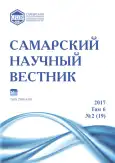Modern state and perspectives of amphibian and reptile synantropisation in anthropocoenosiss of Eastern Azerbaijan
- Authors: Novruzov N.E.1, Bunyatova S.N.1
-
Affiliations:
- Institute of Zoology of Azerbaijan National Academy of Sciences
- Issue: Vol 6, No 2 (2017)
- Pages: 65-70
- Section: 03.02.00 – General Biology
- URL: https://journals.rcsi.science/2309-4370/article/view/21799
- DOI: https://doi.org/10.17816/snv201762113
- ID: 21799
Cite item
Full Text
Abstract
Three species of amphibians and 21 species of reptiles were found on the investigated anthropogenically transformed territories of the eastern part of Azerbaijan, which was 32% of 75 species representing the herpetofauna of the republic as a whole. A consistent decrease in the abundance and index of species diversity was revealed with an increase in the degree of development of the territory and the level of anthropogenic impact. The ratio of species in anthropocoenosiss varied depending on the size of their areas. The recreational pressing has presumably less influence on the numbers, but more on the species diversity of amphibian and reptile. In less developed areas, their numbers increase due to the presence of background species. The effectiveness of adaptation of some species of amphibians and reptiles is apparently associated with an adequate response to environmental changes brought about by anthropogenic impact on the natural environment. As the research has shown, anthropogenic impacts contributed to the spread and growth of the numbers of 7 species (2 species of amphibians and 5 species of reptiles). For Absheron Peninsula and Gobustan, such species were Bufotes variabilis, Pelophylax ridibundus, Eremias velox, Cyrtopodion caspius, Emys orbicularis, Natrix tessellata, Macrovipera lebetina. During the period of research, all these species were observed practically in all anthropogenic landscapes and now can be considered promising synanthropes for the regions studied.
Full Text
##article.viewOnOriginalSite##About the authors
Nizami Enver Novruzov
Institute of Zoology of Azerbaijan National Academy of Sciences
Author for correspondence.
Email: niznovzoo@mail.ru
PhD, researcher of Applied Zoology Centre
AzerbaijanSabina Nizami Bunyatova
Institute of Zoology of Azerbaijan National Academy of Sciences
Email: s_bunyatova@mail.ru
PhD, senior researcher, chief of Zoological Museum
AzerbaijanReferences
- Porter K.R. Herpetology. Philadelphia; London; Toronto, 1972. 524 p.
- Вершинин В.Л. Биота урбанизированных территорий. Екатеринбург, 2007. С. 75-85.
- Хайрутдинов И.З. Экология рептилий урбанизированных территорий (на примере г. Казани): автореф. дис. … канд. биол. наук, Казань, 2010. 24 с.
- Джафарова С.К. Возможности приспособления некоторых видов пресмыкающихся к измененным условиям существования // Фауна, экология и охрана животных в Азербайджане: сб. науч. тр. Баку: Изд-во АГУ, 1987. С. 59-61.
- Искендеров Т.М. Влияние антропогенных факторов на состояние популяции закавказской гюрзы Macrovipera lebetina obtusa Dwiqubsky, 1832) // Материалы V съезда Герпетол. об-ва им. А.М. Никольского. СПб.: ЗИН РАН, 2012. С. 97-99.
- Макеев В.М. Трофические связи ядовитых змей и антропогенный пресс // Вопросы герпетологии. Л.: Наука, 1973. С. 119-120.
- Исаков Ю.А. Процесс синантропизации животных, его последствия и перспективы // Синантропизация и доместикация животного населения. М.: Изд-во МГУ, 1969. С. 3-6.
- Новрузов Н.Э., Ганиев Ф.Р. К изучению герпетофауны Апшеронского полуострова в Азербайджане // Биол. разнообразие Кавказа и Юга России: мат-лы XIV междунар. науч. конф. Махачкала, 2012. С. 208-210.
- Шилов И.А. Экология. М.: Высшая школа, 2000, 512 с.
- Гарибов Я.А., Исмайылова Н.С. Закономерности антропогенизации основных типов естественных ландшафтов прикаспийских равнин Азербайджанской республики // Каспийское море: прошлое, настоящее, будущее: мат-лы междунар. науч. конф. Махачкала, 2014. С. 318-319.
- Area calculator tool by Google maps [Электронный ресурс] // http://3planeta.com/googlemaps/google-maps-area-calculator-tools.html.
- Клауснитцер Б. Экология городской фауны. М.: Мир, 1990, 248 с.
- Росицкий Б., Кратохвил И. Синантропия млекопитающих и роль синантропических и экзоантропических грызунов в природных очагах болезней // Чехосл. биол. 1953. Т. 2, № 5. С. 283-295.
- Куранова В.Н. Особенности биологии амфибий и рептилий крупного города // Вопросы герпетологии. Л.: Наука, 1989. С. 132-133.
- Гусева А.Ю. Влияние степени освоенности территорий на численность и разнообразие земноводных и пресмыкающихся // Человек. Природа. Общество: Актуал. пробл.: Межвуз. конф. мол. ученых. СПб., 1992. С. 56.
Supplementary files







